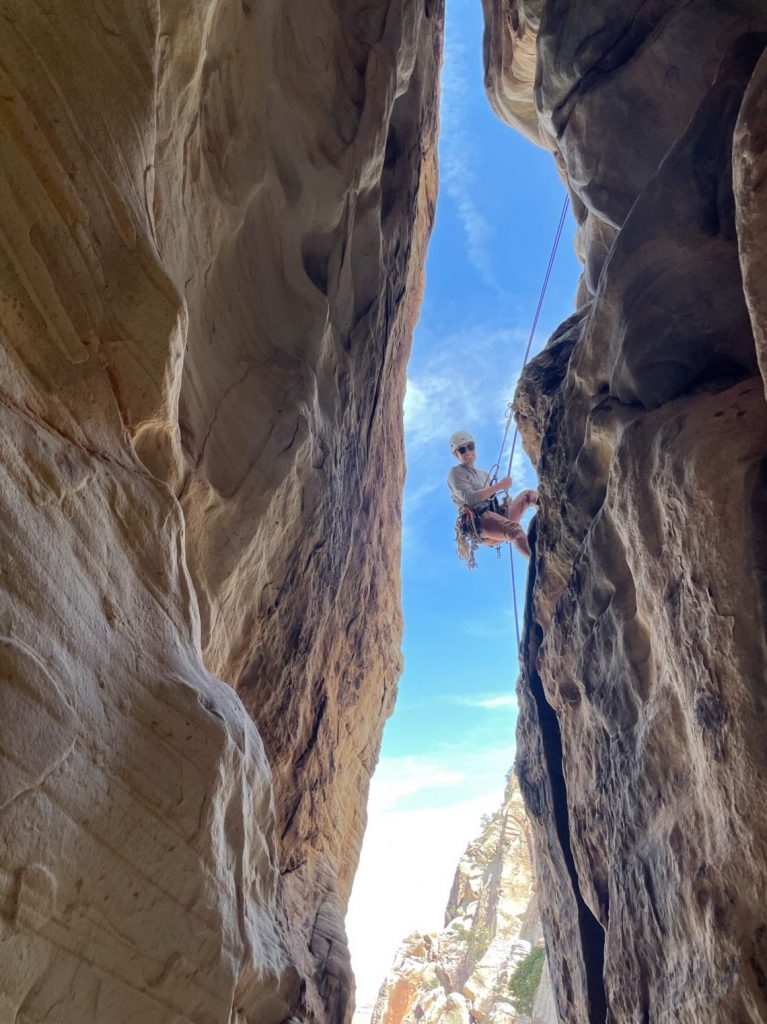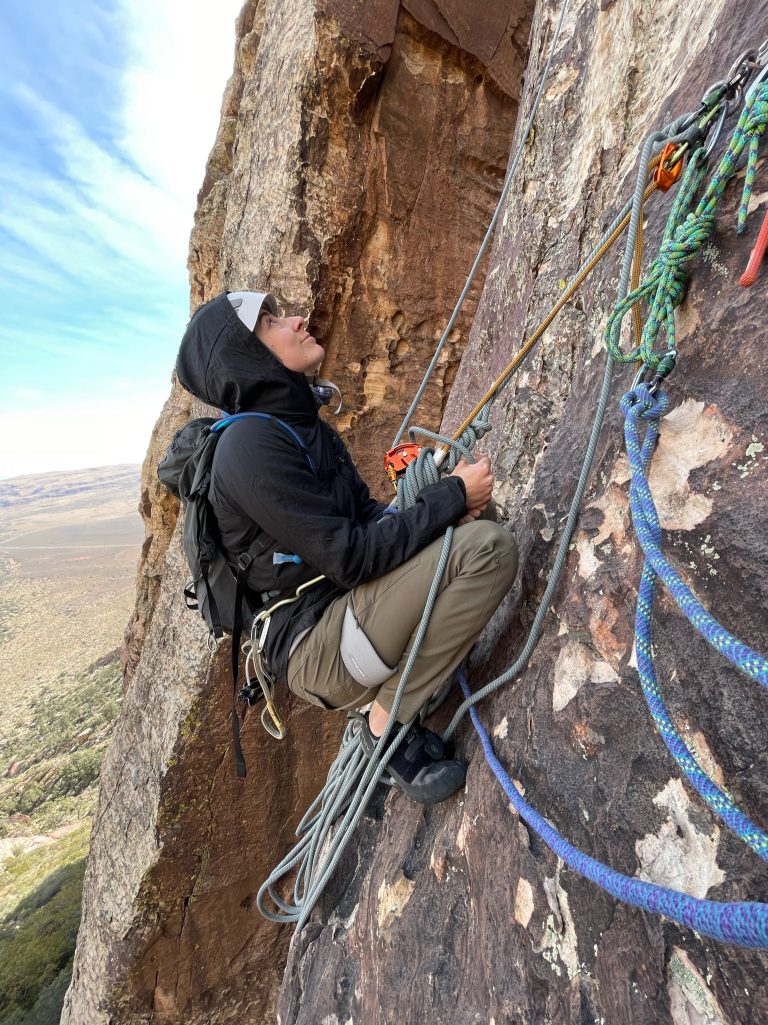By Gabi Tunucci, ’23, as it appeared in the Spring 2023 edition of Crescent magazine.
When faced with a challenge, many people might try to take the easy way out. There are a select few, however, that not only meet these challenges head-on, but also actively seek them out. Diana Adams, an avid rock climber, is one of those select few.
When Adams, senior studio art-graphic design major, isn’t hard at work in her graphic design classes or sketching out new projects, she can usually be found dangling from rugged cliffsides, expertly positioned, pulling herself steadily upwards with carefully calculated movements.
Both locally and internationally, rock climbing’s popularity has grown exponentially in recent years. A testament to this burgeoning interest was rock climbing’s debut at the 2020 Summer Olympic Games. The new “sport climbing” event attracted athletes from around the globe and combined three different climbing disciplines.
Adams says that this popularity was what first drew her to rock climbing.

“I was looking to make friends,” Adams says. “My husband and I got married and we moved out to Connecticut from Wisconsin. We’d been out here a year, and we were trying to find things to do. We spent a whole year kind of just getting settled in new jobs and getting settled in the area.”
“I was trying to find an activity that would put us in the proximity of kind of outdoorsy, like-minded people, and climbing was exactly the right place to go. Those are just my people: they like to go outside, they like to do hard things, they like to go on adventures. Just about everybody that I spend time with is someone that I’ve met through this activity.”
Adams says that climbing also appealed to her because athletes can tailor the sport to their needs and interests.
“You can start climbing at any time,” Adams says. “Climbing is a sport that’s as easy or as hard as you want it to be, but it has an unlimited range of difficulty. Children can do it, or you can do it well into old age.”
At Southern, the student Rock Climbing Club members share Adams’ appreciation for the community. Club President Josephine Nolet, sophomore physics major, says that climbing is a way for her and her peers to have fun and relieve stress.
“There are two things I love about it,” says Nolet. “One is the community that it brings. It’s just a super supportive community, and every time you’re working on something or you’re projecting something, which is what it’s called when you’re working on a specific route or problem, everybody gets together and is like ‘you got this.’ And [the second is] kind of the physical challenge, as well. You’re trying to physically test yourself to get better; you’re pushing your hand strength, your finger strength, your forearm strength, and so on.”
Club secretary Jonny Colascione, senior, business administration-management major, agrees with Nolet, saying he particularly appreciates the way climbers stick together and support each other.
“The thing that I like about climbing most is the problem-solving aspect of it, where you have to figure out where to position your body to get to the top of that set,” Colascione says. “It’s been a great social outlet, and it’s also been a cool sport to learn about. It’s always fun to try and improve.”
Club member Tim Arvin, freshman exercise and sport science major, says he also felt drawn to the club because of this accepting environment.
“The social aspect is great, considering that sometimes the best moments are when you’re lying on the ground tired out from failing a route so many times, and you and a friend kind of just look up and start trying to figure out how to actually climb it,” Arvin says.
“Another reason I joined the club is because I’m not the best at talking to people, but I did want to make friends at Southern. It was actually really relieving to find that everybody there was super easy to talk to. It’s also a very stress-free zone where you can go and not worry about any form of pressure at all.”
Adams further explains that, in addition to the community, she enjoys the skill-based physical challenges involved in climbing. She says rock climbing requires specific training; pure strength does not guarantee success.
“It’s kind of funny when you go to a gym and you see people coming in, especially guys, that are really strong,” Adams jokes.
“They work out and they’re ‘buff’ and stuff like that. They come in, but that doesn’t mean they can climb. They’ll struggle because it’s a high-skill sport. It’s also a movement-based sport, so you can be a lot of different body types. Being super strong, and just being super strong, doesn’t mean that you’ll be able to climb right away. You have to gain the skills, too.”
Adams says that learning to climb goes beyond even physical ability. Rock climbing poses unique challenges that involve complex thinking and problem solving.
“Learning how to climb is a type of reading. Most people look at a rock or wall and they just see rock. If you’re a climber, and you’re going to try to climb something, you’re reading, you’re trying to find a route. You’re looking for what you’re going to do. It’s like a maze. You’re solving a puzzle,” Adams says.
Adams says that climbing is also mentally challenging.

“It’s part physical, but it’s equally mental,” Adams explains. “It’s being willing to put yourself in positions where you’re taking risks, and how much of a risk you’re willing to take.”
Although Adams admits that overcoming fear may seem daunting to many would-be climbers, she says that fear is a matter of perspective. Fear can paralyze, but it can also motivate.
“A lot of people say they could never rock climb because they’re too frightened,” Adams says.
“That may be true, but only because they’ve already decided. For me, I get scared all the time. It can be one of the biggest motivators to try hard not to fall. Fear is an important influence on my decision making when I’m climbing. Like many things, climbing is, in essence, a series of calculated risks. Fear is important, but it can also be self-defeating. I talk to myself. When I get scared, I tell myself, ‘Feel the fear; do it anyway.’”
Adams also says that climbing requires intense focus, which has helped her mental health by keeping her in the present moment.
“Nowadays, we’re so much on our phones and in front of screens and TVs and stuff like that,” says Adams. “But when I’m climbing, I never, not for a moment, think about something that’s happening on my phone. To have that kind of break, to me, there’s value just to that. I’m not using technology or worried about anything else. I’m totally in the moment.”
This constant, mindful practice has taught Adams to slow down and only think about one issue at a time.
“When you’re climbing, the phrase is ‘slow is smooth, and smooth is fast,’” Adams says.
“It works for a lot of things in life: you can’t rush it. You have to do everything in a way that’s smooth so that you can conserve your energy, trying to make things as efficient as possible. No one’s going to tell you how to climb something. There’s sort of that beauty of movement when you find a way to move that feels effortless, but it’s really, really hard.”
This mentality has positively impacted Adams’ professional work as well, allowing her to face big projects head on by breaking them down into smaller steps and appreciating every accomplishment along the way.
“I have a hard time looking at those long, long-term goals,” Adams says.
“I like looking at things in front of me, and challenges in front of me. In climbing, that gives me the opportunity to pick apart the struggle at hand. It puts me in the here and now. This is the thing I can do right now. There may be 50 moves on this route that I’m trying to climb, but the problem that I’m having right now is this move. Let me hang here and work through this move.”
Adams says that honing each individual move also helps her avoid getting overwhelmed.
“It keeps you from being distracted from the whole thing,” Adams says.
“If I can go out today and work on this part of the route that I’m struggling with, if I can figure out this one thing, the next time I come out, I’ll work on the next hard spot. It gives you this sense of accomplishment, that even if I did just this one thing, I got better.”
In this way, Adams explains that climbing requires positive self-talk, and says that it encourages a growth mindset, rather than a craving for immediate success.
“If you tell yourself something enough, you will eventually believe it. Whether your self-talk is positive or negative, it becomes you. I like to tell myself that I like heights and that I like falling. I have to remind myself that if I’m trying hard, I have succeeded, because if I’m not failing, I’m not pushing myself,” Adams says.
“After all, I’m not climbing to be the best climber. That’s not really what it’s about. It’s for personal growth, and it’s fun.”
Those rare successes are what make climbing such a popular and life-changing sport, according to Adams.
“One of the reasons climbing is so addicting is the variable reward of success,” Adams explains.
“It’s the dopamine of sending a route or a boulder that you have been trying and failing at for so long. The truth is, I think, if you’re trying things that are really hard, there might only be a handful of times every year that you succeed at something you’re trying to do. But it’s that super intermittent reward that sticks with you, that feeling, those successes. If it happened all the time, it wouldn’t be the same. I guess it’s like a version of gambling where you’re betting on yourself.”


